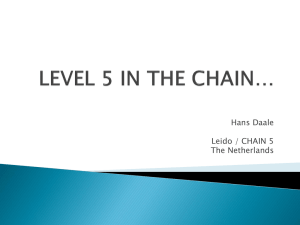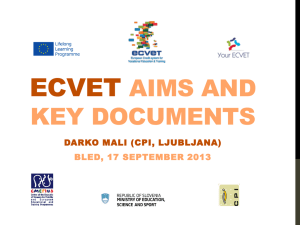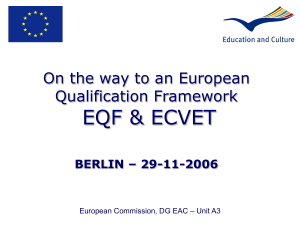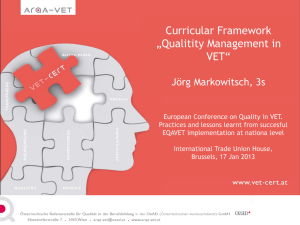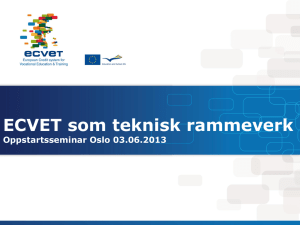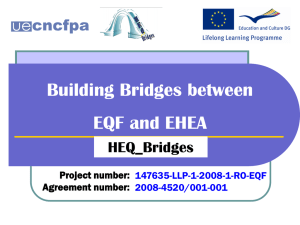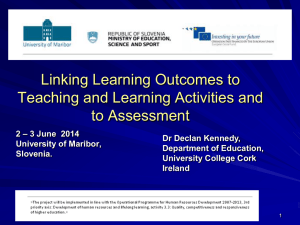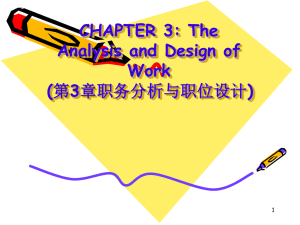Teaching of Modern languages in Wales (UK)
advertisement
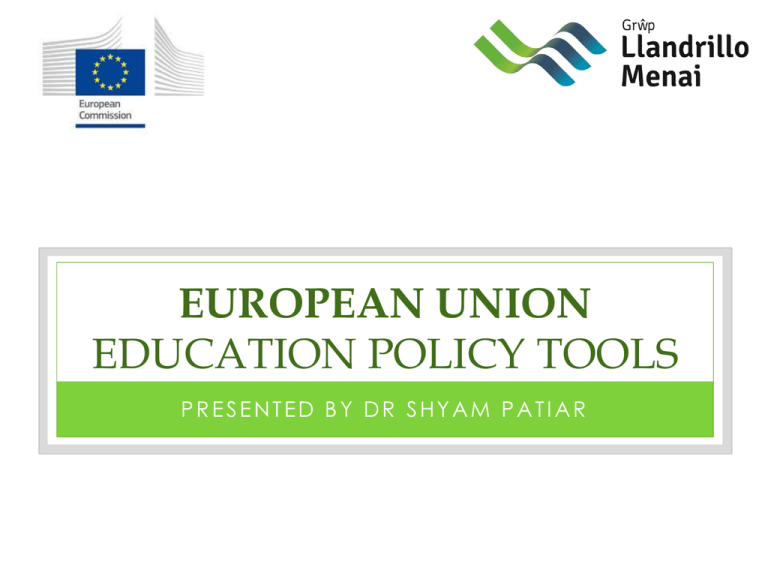
EUROPEAN UNION EDUCATION POLICY TOOLS PRESENTED BY DR SHYAM PATIAR NQF Qualifications by level across the NQF and QCF EQF The European Qualifications Framework (EQF) is an overarching qualifications framework that links the qualifications of different countries together. The aims of the EQF are to help develop a European-wide workforce that is mobile and flexible, and to aid lifelong learning. Benefits of the EQF For employers and learning providers, the EQF will make it easier to compare the level of qualifications from different national systems. EQF System The EQF uses eight levels that are based on the knowledge, skills and competence required to achieve the qualification. The eight levels cover the entire span of qualifications. DESCRIPTORS DEFINING LEVELS IN THE EQF Level Knowledge Example 1 Basic general knowledge Vocational high school 2 Basic factual knowledge of a field of work or study Vocational high school 3 Knowledge of facts, principles, processes and general concepts, in a field of work or study 4 Factual and theoretical knowledge in broad contexts within a field of work or study Higher diploma 5 Comprehensive, specialised, factual and theoretical knowledge within a field of work or study and awareness of the boundaries of that knowledge Bachelor of Arts 6 Advanced knowledge of a field of work or study, involving a critical understanding of theories and principles 7 Highly specialised knowledge at the forefront of knowledge in a field of work or study, as the basis of original thinking and/or research , critical awareness of knowledge issues in a field and at the interface between different fields 8 Knowledge at the most advanced frontier of a field of work or study and at the interface between fields Vocational college diploma Honours Bachelor Degree Masters Doctorate The work to reference the UK frameworks to the EQF has been completed. The referencing of the levels in the UK frameworks to EQF is illustrated in the following table: EQF QCF CQFW SCQF EHEA (Bologna) 8 8 8 12 3rd Cycle 7 7 7 11 2nd Cycle 6 6 6 10/9 1st Cycle 5 5/4 5/4 8/7 Short Cycle 4 3 3 6 3 2 2 5 2 1 1 4 1 E3 E3 3 E2 E2 2 E1 E1 1 SCOPE OF THE EQF The EQF will relate different countries' national qualifications systems to a common European reference framework. Individuals and employers will be able to use the EQF to better understand and compare the qualifications levels of different countries and different education and training systems. The EQF will not: replace existing national qualifications systems or require them to be adjusted in any way. Countries will not be required to sign up to the EQF – it is voluntary. INTERNATIONAL STANDARD CLASSIFICATION OF EDUCATION (ISCED) 2011 Level 8 Academic or Professional Level 7 Academic or Professional 19-21 years (3 years) Level 6 Academic or Professional Doctoral or equivalent level Masters or equivalent level Bachelors or equivalent level Tertiary Education Level 5 General or Vocational Level 4 Post Secondary Non-Tertiary Education General or Vocational 17-18 years (2 years) 12-16 years (5 years) 7-11 years (5 years) 3-6 years (4 years) 0-2 years (2 years) Level 3 General or Vocational Level 2 General or Vocational Upper Secondary Education Lower Secondary Education Level 1 Primary education Level 02 Pre-Primary Education Level 01 Early Childhood Educational Development Published by UNESCO – Institute for Statistics, 2011 Secondary Education Early Childhood Education ECVET Linked European Initiatives to support ECVET ECVET forms part of a range of European initiatives to strengthen and help to make European mobility a reality for many more people. Other initiatives linked to support ECVET are: EQF (European Qualifications Framework) is a reference framework that acts as a translation device comparing qualifications and levels across Europe. EQAVET (European Quality Assurance Reference Framework for VET) aims to promote mutual trust and understanding across European VET systems and providers by promoting transparency and intelligibility in the practice of quality assurance. EUROPASS aims to make skills and qualifications clearly and easily understood in Europe ‐ whether enrolling on an education or training programme, looking for a job, or getting experience abroad. ESCO (European Skills, Competences and Occupations) aims to link the national data systems in Europe describing the occupations in the national labour markets and the skills and competences needed for jobs. WHY ECVET? • ECVET for mobility and recognition • ECVET for lifelong learning • ECVET for attractiveness of VET ECVET IS BASED ON: • Learning outcomes - statements of knowledge, skills and competence that can be achieved in a variety of learning contexts. • Units of learning outcomes that are components of qualifications. Units can be assessed, validated and recognised. • ECVET points, which provide additional information about units and qualifications in a numerical form. • Credit for assessed Units. Credit can be transferred and accumulated to achieve a qualification. • Mutual trust and partnership among participating organisations are expressed in memoranda of understanding and learning agreements. Although ECVET is underpinned by European legislation, participation is voluntary and national protocols are respected. In 2014 the European Parliament and the Council will review and evaluate the first stage of ECVET implementation and, if required, they will readjust their Recommendations. ECTS The European Credit Transfer and Accumulation System (ECTS) aims to make study programmes in Europe easier to read and compare. It assigns credits to course components based on the student workload required to achieve the objectives of the particular course of study. These objectives are usually described in terms of the learning outcomes of the course and the competencies to be acquired. ECTS was introduced as part of the Erasmus framework in 1989. It is the only credit system which has been successfully used across Europe, and began life solely as a credit transfer system. In helping European countries to mutually recognise periods of study abroad it assists student mobility. More recently, ECTS has developed into a credit accumulation system to be implemented at institutional, regional, national and European level. It ties in closely with the Bologna Process objectives of establishing a system of credits and the adoption of a system of easily readable and comparable degrees for the European Higher Education Area. ECTS The workload of a full-time student during one academic year is calculated to be 60 ECTS credits. Workload refers to the average time a learner might be expected to reach the required learning outcomes. ECTS credits can only be obtained after appropriate assessment of the learning outcomes the student has achieved. ECTS makes teaching and learning in higher education more transparent across Europe and facilitates the recognition of all studies. The system allows for the transfer of learning experiences between different institutions, greater student mobility and more flexible routes to gain degrees. It also aids curriculum design and quality assurance. EQAVET The European Quality Assurance Reference Framework for Vocational Education and Training (EQAVET) is the outcome of a Recommendation, adopted by EU Member States in June 2009, from the European Commission to establish a reference instrument to help Member States to promote and monitor continuous improvement of their VET systems based on common European references. The aim of EQAVET is to contribute to quality improvement in VET and to increased transparency of, and consistency in, VET policy developments between Member States, thereby promoting mutual trust, mobility of workers and learners, and lifelong learning. EQAVET LIST OF INDICATORS: 1. 2. 3. 4. 5. 6. 7. 8. 9. 10. Relevance of quality assurance systems for VET providers Investment in training of teachers and trainers Participation rate in VET programmes Completion rate in VET programmes Placement rate in VET programmes Utilisation of acquired skills at the workplace Unemployment rate Prevalence of vulnerable groups Mechanisms to identify training needs in the labour market Schemes used to promote better access to VET EQAVET EQAVET is a reference tool for policy-makers based on a four-stage quality cycle that includes goal setting and planning, implementation, evaluation and review. Member States are encouraged to use the framework, and develop, by mid-2011, a national approach to improving quality assurance systems that involves all relevant stakeholders. This approach should include the establishment of national reference points for quality assurance, as well as active participation in the relevant European-level network. EUROPASS Europass is a new initiative which aims to help people make their skills and qualifications clearly and easily understood in Europe, thus facilitating the mobility of both learners and workers. The Europass documents have been designed in such a way as to help people chronicle their skills and competences in a coherent manner, whether they are planning to enroll in an education or training programme, looking for a job, or getting experience abroad. Europass consists of a portfolio of five documents as follows: Two documents which individuals can complete independently EUROPASS Europass consists of a portfolio of five documents as follows: Two documents which individuals can complete independently • Europass Curriculum Vitae (CV) • Europass Language Passport Three documents which are completed by the competent organisation on behalf of the individual • Europass Mobility • Europass Certificate Supplement • Europass Diploma Supplement EUROPASS BENEFITS Europass has five main benefits associated with it, the principal ones being: 1. It will help citizens to convey their qualifications and competences in an effective way 2. It provides a comprehensive tool for users based on an accessible electronic format 3. It enables people with diverse backgrounds and experiences to gain access to opportunities for learning and employment throughout Europe, particularly by helping people to move between countries or across employment sectors 4. It will promote strong links between education and training, business and industry, ensuring the continuing relevance and adequate appreciation of competences and qualifications 5. Europass is an open system that supports European policy developments related to the transparency of competences and qualifications THANK YOU FOR YOUR ATTENTION
